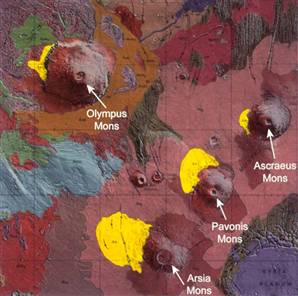Saturday, January 21, 2006
Glacier Debris on Mars?
Brown University scientist James Head thinks so. Several million years ago, Mars' poles may have tilted toward the sun. Ice may have deposited near Mars' enormous shield volcanoes, Olympus, Ascraeus, Pavonis, and Arsia. Today, we have only clues (shown in the yellow-colored sections of this geological map): scraped up deposits of rock and sand on the lower flanks of these "monsters."
 The sun's rays could vaporize the snow in a process known as sublimation, also seen here on Earth. Winds would carry the water vapor south, up and over the soaring slopes of the Tharsis Montes volcanoes and the giant Olympus Mons volcano.
The sun's rays could vaporize the snow in a process known as sublimation, also seen here on Earth. Winds would carry the water vapor south, up and over the soaring slopes of the Tharsis Montes volcanoes and the giant Olympus Mons volcano.
The vapor would cool and condense into snow, which would eventually harden into an icy glacier.
"The findings are important because they tell us that Mars has experienced big climate changes in the past, the kinds of climate change that led to the Great Ice Age here on Earth," Head said.
"The findings are also interesting because this precipitation pattern may have left pockets of ice scattered across Mars. This is good information for NASA as officials plan future space missions, particularly with astronauts."
Lacking a large moon, a planet is more inclined to wider fluctuations in axial tilt. In fact, some scientists theorize that without our moon, Earth would never have had a long-term stability in climate that permitted life to take root and thrive. Those volcanoes dwarf earth corollaries because there is no continental drift on Mars. On earth, the crust moves over these interior hot spots and causes chains of islands (like the Hawaiian) or a series of continetnal volcanic deposits (as is true with Yellowstone). On Mars, the buildup continued until Mars' interior hot spots cooled off--which scientists think was 100 million to a billion years ago.